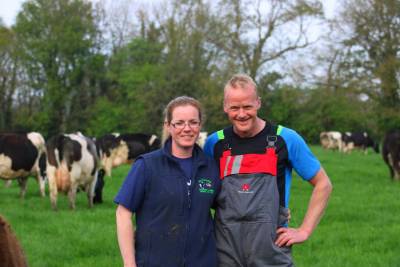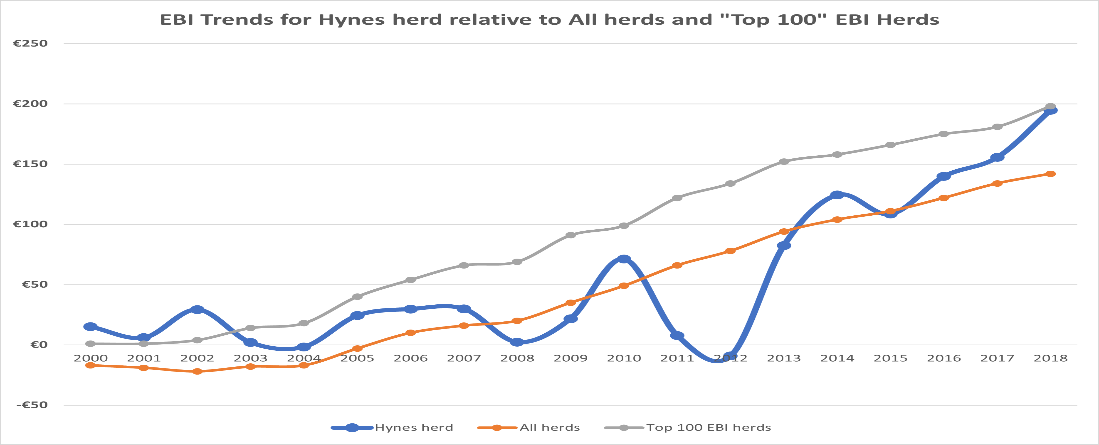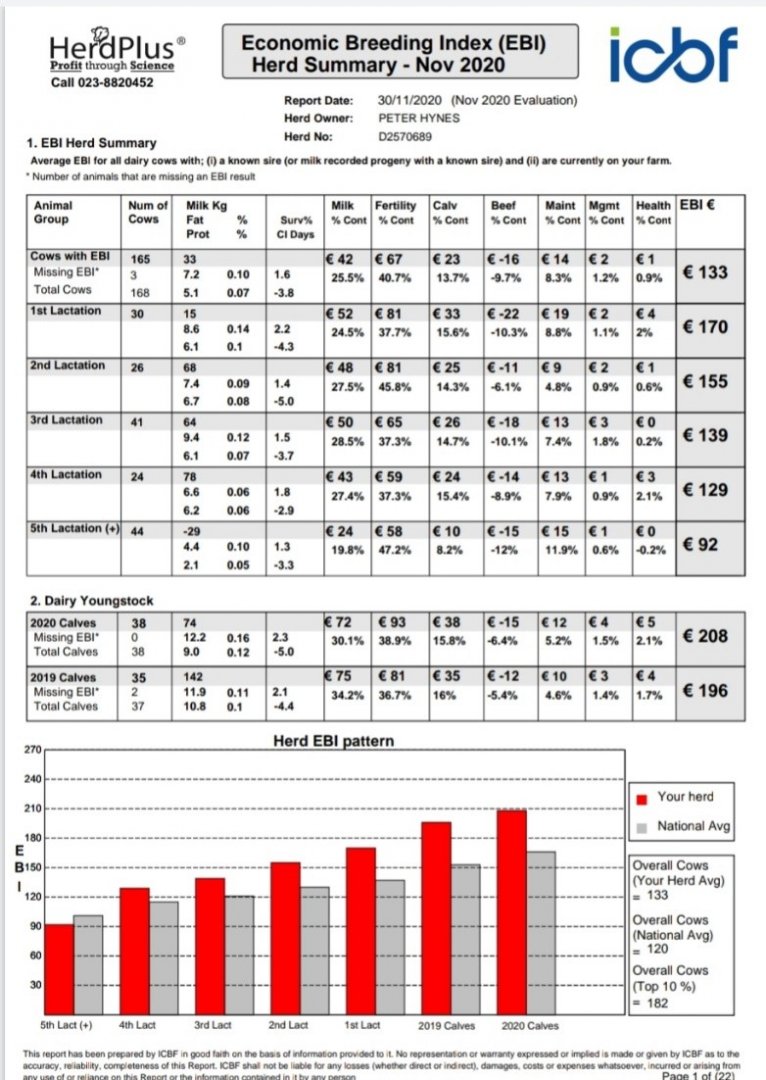
My farming career didn’t begin until 2010 when at the age of 36 I returned home to Aherla to what is now Rathard Holsteins. At the time the herd comprised of fifty cows grazing 240 days a year producing 270kgs milk solids per cow. The herd was spring calving with a 31- week calving spread and a calving interval of over 400 days. No AI was being used on farm with a Friesian stock bull being used to breed replacements whilst the herd was being mopped up by an Aberdeen Angus stock bull once it had served all the heifers. All heifers were calved down at 36 months.
Whilst my immediate focus was on educating myself through agricultural college and discussion groups along with changing grassland management it was imperative for the longterm benefit of the herd that I improved the breeding program along with increasing genetic gain. I completed an AI course in 2011 to gain a more educated view on the breeding cycle of dairy cows.
In 2012 a team of daughter proven AI bulls was selected for the herd with the help of breeding advisor Eustace Burke whom is still a key part of the farm team. I believe it is vital a progressive dairy farm has a good breeding advisor who understands the herd but also has clear sight of the long-term vision for the herd. I commenced AI in 2012 whilst also shortening the breeding season to 12 weeks. We use EBI (economic breeding index) which is a single figure profit index aimed at helping farmers identify the most profitable bulls and cows for breeding dairy herd replacements. Our average herd EBI at the time was 62 with a target of 110 by 2020 through genetic gain.
High EBI genotyped bulls were starting to become more available in Ireland but with a view to expanding the herd with removal of EU quotas in 2015 I decided to go the route of using sexed semen in 2013 ensuring we would have maximum numbers of home-grown replacement heifers calving into the herd in 2015. I also decided to switch to using an AI technician as whilst I had been successful at AI cows myself the fact that a technician serves between 10,000 and 20,000 cows each year solidified to me that their strike rate would ultimately be better than mine. A missed heat or missed serve costs the farm 250 euro per cow therefore using a top-class technician can easily be financially justified.
Sexed semen was successful for us with a 65% strike rate on cows to first service. Cows selected for sexed semen had to tick all the right criteria for us, early calving with no calving issues and no metabolic issues. Heifers were switched to calving at 24 months and in 2014 my wife Paula also joined the farm whom herself has now also obtained an AI license.
Rathard Holsteins comprised of 100 cows in 2015 with the herd being doubled in one calving season with a further view to expanding to 120 cows in 2016. Whilst our grazing season was now maximized to 320 days at grass it became clear that maximizing genetic gain would see the greatest gains long term. The decision was taken to switch to using genotyped bulls in 2015 along with genotyping all heifers giving us increased reliability and data on dairy stock.
Our calving interval had reduced to 374 days by 2015 with a 6-week calving rate of 54% so parameters were going in the right direction but ultimately herd expansion slows down the rate of improvement as ultimately every cow available to be milked stayed within the herd and our vision was to get to 180 cows as fast as possible. Milk price was still slightly below the co-op average with cows producing 350kgs milk solids per cow.
Having grown a close connection with NCBC (national cattle breeding center) which flys under the Ireland Genetics flag in the UK we took the decision to use a team of G1 bulls for AI which are essentially elite young genomic bulls. Further to that myself and Paula also took the decision to use these bulls for breeding our maiden heifers. I must stress that we do look at back breeding on these bulls to check for any signs of calving difficulty as it is not recommended to use the bulls on heifers without any calving data however this is a decision that has worked to our advantage with no difficulty in calving heifers.
We calved down 150 cows in 2017 with enough replacements on the ground to take us to 180 cows in 2018. 2017 was also the year we won the farmer of the year but also built new facilities to allow for cow comfort, better cow flow and ease of management. The milking parlour was upgraded from an 8 unit to a new 20 unit all designed for ease of cow flow. A new cubicle shed was built increasing the number of cubicles from 60 to 195 with enough feed rail for 240 cows. We strongly believe in order to maximize production from cows, they require comfort with no competition for feed (see Table
below).

Average herd EBI stood at 102 in 2018 however the average EBI for our 2017 born calves stood at 148 with the average for our 2018 calves being 174. We had reduced the herd calving interval to 364 days by 2018 with a 6-week calving rate of 84% along with 84% of heifers calved at 24 months. The average EBI for the team of bulls we used in 2018 stood at 279 and genetic gain was finally starting to be reflected in milk price with our average price being 36 cent for the year which was 1 cent above the co-op average.
2019 became the year where hard work and decisions finally came to fruition. We finally had surplus heifer calves to sell. All heifer calves were reared on farm to 12 weeks of age and were also genotyped. A detailed look at the genetic breakdown of all heifer calves, analyzing which heifers were getting big EBI gains through genotyping led us to compiling a list of 40 heifers to be retained on farm with all surplus made available for immediate sale commanding above market prices with the view being taken it would not be financially viable to rear these surplus heifers to point of calving and a better route being to put all our efforts into rearing required stock. 2019 also saw our homebred heifer Rathard Alanna winning the All Ireland Munster EBI championship and she also went on to win the highest genetic merit female at the National Dairy Show. Born with an EBI of 279 which climbed to 292 after genotyping, she is sired by FR4513 whom we used as a first season sire. Her granddam still sits within the top seven EBI cows in the herd along with 4 other family members. The granddam has since produced a bull calf with an EBI of 316 sitting higher than his sire.
Rathard Alanna has held her EBI at 292 after 18 months and 9 proof runs and is due to calve on 3rd February 2021 incalf to a G1 sire FR5530.
We also changed to synchronizing all heifers in 2019 using CIDRs with a 70% incalf rate to first service. The important thing in breeding heifers through synchronization is that they are already cycling or sexually mature. We took this breeding decision for ease of management due to busy workloads at the start of the breeding season and believe the extra cost is recouped through less time required for heat detection on heifers, days gained in milk and higher conception to AI. The positive impact this has shown is that due to heifers having more time to recover from calving we have seen a higher incalf rate to first service for our first lactation cows in 2020. Again, all heifers were synchronized in 2020 using CIDRs with 68% in calf to first service.
2020 has seen the herd progress with only 7% of cows empty after a 12-week breeding season. 100% of heifers incalf and 150 due to calve in the first four weeks of calving in 2021. Average herd EBI now stands at 133 which is 23 points above our 2020 target. The average EBI for our 2019 born heifer calves is 196 with the average for our 2020 calves being 208. Again, surplus heifer calves were sold at 12 weeks of age following genotyping and we also sold 6 bulls as stock bulls. The extra financial return for the farm from selling top quality dairy stock is a great asset for any business (see Figure 1).
Figure 1: EBI Trends for Hynes herd relative to All herds and ‘Top 100’ EBI Herds.

The key learning point surrounding genetic gain on farm is that taking wrong decisions can have a disastrous effect on a dairy herd which can leave a lasting impact on a herd as shown in the graph. The herd was well placed genetically in 2002 however breeding decisions impacted the herd very quickly with the herd not regaining the same genetic potential until 2009 but again breeding decisions negatively impacting the herd until a change in breeding strategy in 2012. A clear vision of where we wanted to take the herd genetically in 2012 has seen genetic gain climb to that of the top 100 herds by 2020 albeit at a far greater pace with the herd genetic gain being over double that of the national average and top 100 herds. In order to maximize genetic gain a farm must have a strict breeding strategy, a clear vision and patience combined with belief. It has taken us 8 hard years to get to where we are, however now we are in a position where genetic gain will snowball dramatically year on year.
Our policy has remained the same over the last few years, use a team of elite genetic merit bulls, look at our herds requirements and match bulls to individual females depending on their genetic breakdown. Bulls must have a well-balanced EBI with a clear focus on fertility index, positive in kgs of milk with high constituents and health traits must be positive. Sires we have used over the last number of years include HZB, LWR, FR2298, FR4513, FR4728, FR4760 etc. but it is important to remember all these sires were used as first season sires.
Lastly, we believe every farm requires a top-class breeding team. The AI technician can only reach top targets if heat detection is top-class with cows being presented for insemination at the correct time. Breeding advisors must be a part of the vision and also what genetic improvements the herd requires. Myself and Paula are indebted to the team at the NCBC whom have spent many hours walking the herd looking at stock with us, for spending numerous hours discussing genetic breakdown of the herd and for allowing us access to elite panels of bulls with the belief that we would make the best breeding decisions possible. That belief combined with the top-class data constantly available from the ICBF and Teagasc researchers has allowed us constantly track herd progress.
I firmly believe a fully genotyped herd is better positioned with the rapid evolution of research and has an advantage in data reliability to fully capitalize on lowering carbon footprint at a greater pace with the compilation of data on cows which produce less methane ultimately being the most carbon efficient cows per kg milk solids. That is the future for greener dairy, a holy grail which will be upon us sooner than we envisage. We as dairy farmers have the power to inspire researchers to achieve greater things by simply affording them the belief that we are implementing their work at a rapid pace.
